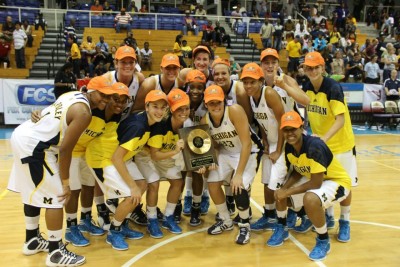
For basketball fans, March can be a wonderful time. The NBA playoff race is heating up, high school state championships are in progress and the NCAA has its postseason tournaments. To put it simply, March is true madness for a basketball fan.
If you picked a bracket for the men’s tournament, it’s probably just as busted as mine. This year’s rendition had 15 seeds winning, 12-seeds versus five-seeds in disarray and unexpected winners advancing at an unparalleled rate.
If you’re even more of a basketball fan and filled out a women’s bracket, odds are you’re pretty close to perfect. And if you have the University of Connecticut winning the whole thing, then you’ll probably be correct as well.
Many people complain about the women’s tournament not being as widely viewed or discussed as its male counterpart. While this is completely true, it’s because the tournament is so predictable that watching it from start to finish is not interesting.
The change from halves to quarters in women’s basketball this season has sped the game up to make it much more exciting to watch. But at the end of the day, UConn still wins.
Even though there may not be as many upsets in the women’s game, there is still the same exhilarating action come tournament time. But at the end of the day, UConn still wins.
And when UConn isn’t involved, games tend to be filled with wire-to-wire excitement. But at the end of the day, Baylor University will probably find a way to win.
If you haven’t caught on yet, the top teams in the country are usually so superior that it’s unlikely we will see a major upset or a Cinderella story whatsoever.
For instance, the current women’s tournament has only had two major upsets, both of which were a 12-seed over a five-seed. And by major upset, I don’t mean a nine-seed over an eight-seed or a 10-seed over a seven-seed, because you might as well just flip a coin for those. I’m talking about top seeds being sent home early.
Two seven-seeds reached the Sweet 16 in this year’s tournament, and one is The University of Tennessee, a perennial postseason powerhouse. The other is the University of Washington. While both have amassed impressive runs, their efforts are far from the norm.
Here’s another certainty: one-seeds might as well just get a bye to the Final Four. Playing a one-seed is practically a death sentence. And that goes for both the men’s and women’s brackets.
However, this phenomenon is more common in the women’s bracket, as 16-seeds are absolutely embarrassed and demoralized by their opponents. For example, UConn defeated Robert Morris University by a score of 101-49, which is an absolutely terrible way for a talented team to watch its season end. The same goes for two-seeds and three-seeds who also desecrate their hapless opponents.
It’s almost unnecessary to play the first- and second-round games for top-ranked teams because they just advance regardless. This makes watching the NCAA women’s basketball tournament boring.
For the most part, the whole tournament is really just a formality. The top 64 teams all get together and count down the days until one of the No. 1 seeds lifts the trophy in April. Oh, and they play a couple of games that really won’t matter in the long run.
It’s getting to the point in women’s basketball that you might as well not even play a postseason tournament, and in some cases, even a conference tournament. What are they really going to do? They just give the best teams a few more wins and another trophy. With that being the case, why even try in the first place?
It’s tiring when something is so predictable that you can hang your hat on it before the season even starts. And that’s what makes women’s basketball uninteresting.
So how does this get fixed? My offering might seem far-fetched and will never happen, but it does make sense.
First of all, abolish all conferences in Division I. Second, take the top 20 or so teams and group them together, and so on with down the line with the next 20 teams. Rather than play non-league schedules, play everyone at least once and any regional or local team twice for a total of around 30 games.
At the end of the season, the top 16 teams go to a “conference tournament,” and the bottom four teams get knocked down to the next level. The top four teams from the level below get promoted to a higher conference.
Soccer-esque? Yes. Sensible? Yes. Happening? Probably not. But wouldn’t that be more exciting than watching UConn beat up on weaker teams to win each year? Of course.
The ball’s in your court now, NCAA. And yes, pun intended.




















































































































